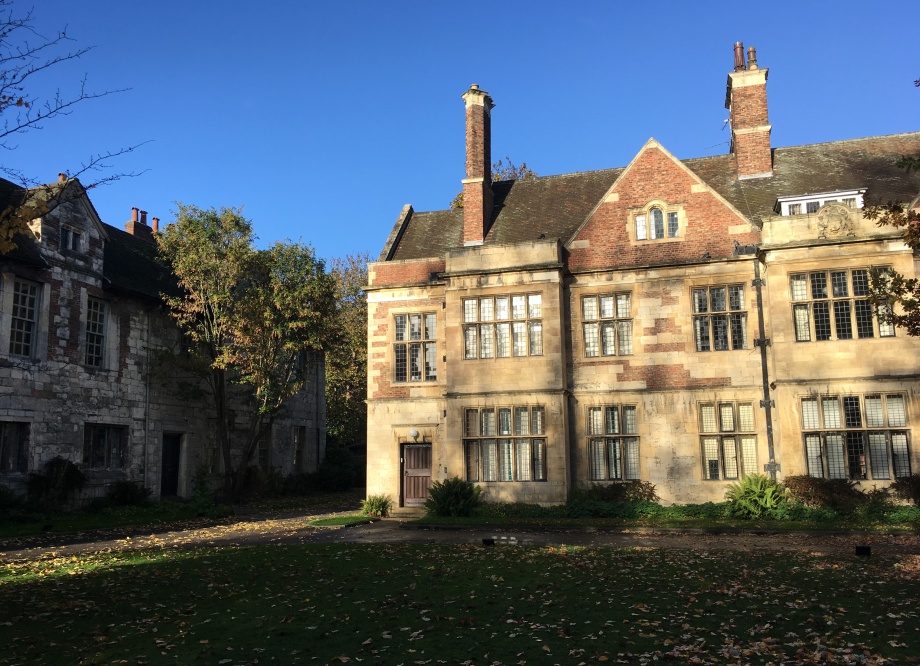As a writer of a historical novel set in Tudor York and two non-fiction books about the history of the city during this time, I was excited to attend York Theatre Royal’s community production of CJ Sansom’s novel Sovereign.
For those who don’t know, the story is primarily set in the York leg of Henry VIII’s northern progress of 1541. The evening of my visit was beset by rain, but nothing could take away from the stunning location in a central courtyard at the King’s Manor in York. This was the same building where Henry and his wife Catherine Howard lodged during the King’s only visit to the city.
Thankfully, the choir (sat to one side of the main space) and the audience (comfortably arranged in tiered seating to give a brilliant view) were undercover. Although the actors were not, it was difficult to tell from the performance they gave just how wet they must have been.
The show lasted for three hours, including a thirty-minute interval. Sovereign has a fairly complicated plot, and the production did well to pack so much of it in. London lawyer Matthew Shardlake and his assistant Jack Barak come to York to carry out legal business linked to the King’s progress. In a nice touch at the beginning, Jack makes a quick impression on the audience by criticising the North of England and York in particular.
The pair soon find themselves investigating the mysterious death of a glazier, and unwittingly become embroiled in a conspiracy against the King. When Matthew uncovers a mysterious box filled with documents, it’s clear someone thinks he knows too much. Several attempts are made on his life. In parallel, Jack falls for Tamsin, a confectioner in the royal household. After a late-night tryst, the couple witness something they shouldn’t. They too are soon placed in danger.
The production brings to life several aspects of Tudor York, including the widespread disenchantment with the religious reforms carried out during the latter years of Henry’s reign. The Dissolution of the monasteries and religious houses, amongst other things, was an economic disaster for the city. During the early stages of the Dissolution, the North rebelled. As part of the Pilgrimage of Grace, lawyer Robert Aske brought a rebel army to York. After being tricked by Henry VIII and his advisers, Aske was hanged in chains at Clifford’s Tower.
One of the religious houses closed in York during the Dissolution was St Mary’s Abbey. The King’s Manor where the performance was held was formerly the abbot’s house. The closed courtyard used for the production was a remarkable setting. In the early scenes of the performance, Robert Aske’s remains can be seen hanging from one corner. Areas of the space were constantly being used for different purposes from streets in York to prison cells in the Castle Prison and the Tower of London, to various houses, tents, carriages and a ship. Even the mullioned windows were put to good use, as Tudor toilet waste was thrown down from upstairs onto the authorities below.
I’ll refrain from spoilers for anyone who might not have yet read the excellent book, or perhaps (like myself) may be inspired to revisit it after many years. Suffice to say, the intrigue continues until the very end, when the secrets are revealed.
Highlights for me personally included the performance of the actors playing Jack and Tamsin, who I thought were excellent. Matthew was good too, although having read the books I have a different actor in my mind for the role which perhaps clouds my judgement. There was a huge ensemble cast and everyone played their parts very well.
To have a disabled character as the protagonist is powerful. When I read the book, the most compelling and memorable scene for me was during Henry’s approach to York at Fulford Cross and, in particular, his verbal attack on Matthew. You could feel his pain as the crowd laughed and jeered, as the King mocked his disability. This was done very well in the show and left a strong impression, just like in the book.
In terms of powerful impact, I think a little more could have made of York’s authorities grovelling apology to the King for the city’s role in the Pilgrimage of Grace. There was also one slight historical inaccuracy here too. The character, William Tancred, who read out the apology was described as York’s mayor. In fact, although Tancred, who hailed from Boroughbridge (but that’s another story) was the City’s Recorder. The Lord Mayor at the time was Robert Hall. However, that’s a very minor point.
Overall, I thought the production was excellent. The community aspect is wonderful, and I was thoroughly entertained. To watch this performance in such a historic space was a privilege which I’ll remember for a very long time.
For those who couldn’t attend the sell-out Theatre Royal performances. I’d strongly recommend reading or re-reading Sovereign and all the other Shardlake novels too. Although it’s set a few decades later, you might like my own Tudor novel, The Pearl of York, Treason and Plot. If it’s the historical facts which fascinate you more, my latest non-fiction book True Tales of Tudor York includes a chapter dedicated to Henry VIII’s visit to York. I know a number of group members have read the books and I’m always very grateful for your support and feedback.
